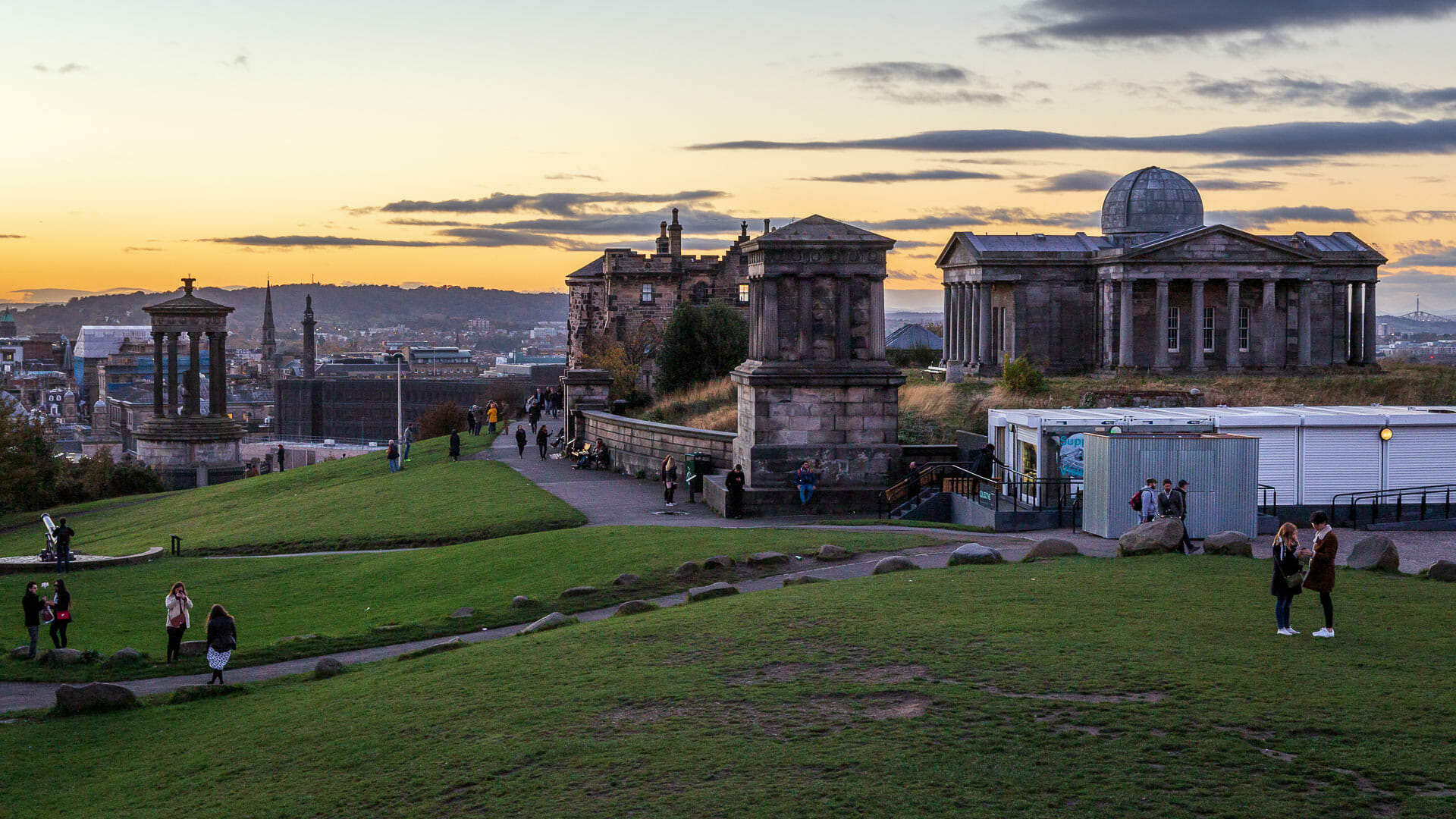When the sun sets in the west of Edinburgh, Calton Hill offers an unrivalled view. But there is much more to discover up there.

Edinburgh is nicknamed the “Athens of the North”. No wonder, as the city is rich in buildings reminiscent of the ancient Greek architectural style. And Scotland’s capital has a further relationship to ancient cities. It stands on seven hills, just like ancient Rome.
One of these hills is Calton Hill.
Calton Hill has a long history: there was once an independent community at the foot of the hill. Later, there was a notorious prison there. Today, however, the house of the Scottish Government is also located at the bottom of the hill.
However, the monuments and buildings at the top of the hill are some of the most interesting. They date back to the 18th and 19th centuries, when Edinburgh’s New Town was built, and commemorate important events in Scottish history.
The short climb to Calton Hill is on most visitors’ itineraries because of the famous view – and is still worthwhile. But the buildings on the hill also deserve attention.
Knowledge: About the buildings on Calton Hill
The National Monument looks like a backdrop. Only twelve pillars stand around more or less pointlessly on Calton Hill. Originally, however, it was to become an entire building commemorating the fallen of the Napoleonic Wars between 1803 and 1815. At least that was the Highland Society’s vision when they appointed Charles Cockerall as architect and William Henry Playfair as his assistant. Both were modelled on the Athenian Parthenon, the temple of Athena on the Acropolis. Catacombs were to be built beneath the building, where famous personalities were to be laid to rest.
Big plans that required a lot of money, which in turn was to be provided by patrons and donors. construction work began in 1826. However, despite well-known sponsors of the project such as Sir Walter Scott, not enough money was raised. Three years and twelve columns were all that was possible. This failure earned the National Monument an unflattering nickname: Edinburgh’s Disgrace.
Today it actually serves as a backdrop for the Beltane Fire Festival, which takes place every year on 30 April.
Right next door, another monument commemorates the Napoleonic Wars. The Nelson Monument was completed in 1816 and commemorates the victor of the Battle of Trafalgar, Vice-Admiral Horatio Nelson. The tower stands on the summit of Calton Hill and rises a further 32 metres. An interesting feature is the time ball, which was installed in 1852 by astronomer Professor Charles Piazzi Smyth. At one o’clock noon each day, a clock released the ball’s holding mechanism via an electrical cable, which then fell down. The sailors in Leith harbour could see this and set their watches accordingly. It was only later that the famous one-o’clock-gun at Edinburgh Castle was added as an acoustic signal.
Probably the largest area on Calton Hill is occupied by the old City Observatory. The central building is reminiscent of a Greek temple. No wonder, as William Henry Playfair was responsible for this, who later also worked on the National Monument. it went into operation in 1818; the domed building with the copper roof is the telescope building. At the other end is an old building, the Thomas Short Observatory, which was erected in the middle of the 18th century – its Gothic style is in stark contrast to the antiquity of the other monuments on Calton Hill.
And then, of course, there is the most famous photo motif on Calton Hill: the Dugald Stewart Monument. Dedicated to a Scottish philosopher, it overlooks Edinburgh and serves as a foreground for photos of the city in the background.
Tip: up Calton Hill at sunset
When the sun goes down in the evening, romantics gather in good weather to look out over the city. Even when I was there in November, amateur and professional photographers jostled for the coveted spots below the Short Observatory. Because from here you can get the Dugald Stewart Monument in front of the lens as well as the Balmoral Hotel, the Scott Monument and Edinburgh Castle in the distance.
But it’s not just the classic motif that is interesting. If you look further around, you can see the modern Omni Centre, for example.
Behind the National Monument you can see the coast of Fife and the harbour of Leith.
Another place worth seeing at the foot of Calton Hill is the Old Calton Burial Ground.
How to get there:
Like almost everything in Edinburgh, Calton Hill is within easy walking distance. It is located at the western end of Princes Street. Both Waverley Station and the bus station in St Andrew’s Square are just a few hundred metres away. It can also be reached from Holyrood Palace by taking a shortcut via New Calton Burial Ground.